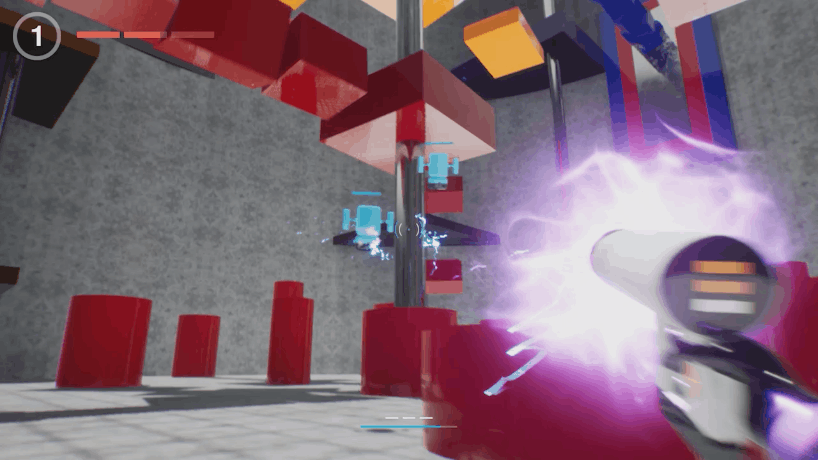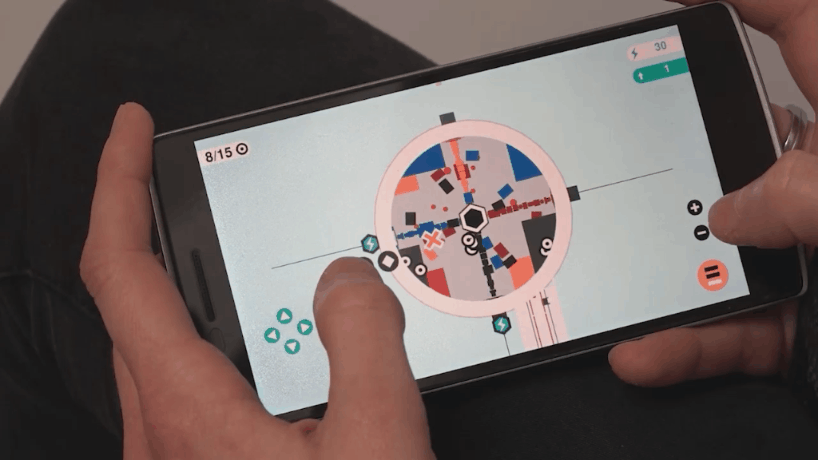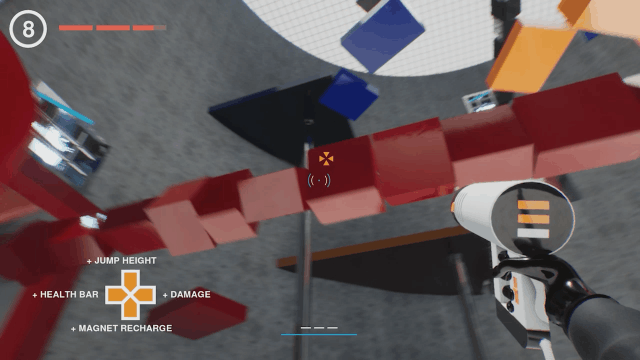


L.A.M.E. is an experimental mix of first-person shooter (PC) and real-time strategy (mobile) gameplay in asymmetric local multiplayer.
GENRE: Asymmetric Multiplayer FPS & RTS
PLATFORM: PC / Android
ENGINE: Unreal Engine 4
TEAM: 6
DURATION: 3 months
TASKS: 3Cs / AI / Balancing / Level Design
ONE GAME, TWO GENRES
Play a high mobility FPS as the Attacker and a mobile RTS as the Defender in local multiplayer. Compete against each other with different goals.
VERTICAL ACTION
As the Attacker, sprint, jump and grapple while fending off waves of enemy drones in a vertical level map.
As the Defender, command the environment and manage your tactics from a top-down perspective.
REACTIVE PROGRESSION
Level up and upgrade your abilities in different directions. React to the progression path of your opponent and explore different playstyles.
The project team consisted of 2 designers (FPS / RTS), 2 programmers (Gameplay / Online) and 2 artists (Modeling / Animation). I was responsible for designing all aspects of FPS gameplay, which required close collaboration with the rest of the team. I also acted as Product Owner to help the team prioritize and ensure timely delivery of the prototype.
GAMEPLAY DESIGN
• Designed and iterated on the grapple ability. — The player can shoot and pull themselves toward a magnet that can be attached on highlighted surfaces. Getting the feel of this ability right was key to achieve high-mobility shooter action and took a lot of research and discussion with the gameplay programmers about feasibility and scope.
• Designed FPS essentials such as projectile-based weapon behavior, recoil and camera shake. — FPS gameplay in L.A.M.E. revolves around continuous and vertical mobility rather than precise aiming. Gunplay was accordingly designed to be more forgiving with slightly homing projectiles and splash damage.
• Co-designed enemy types and AI behavior. — Enemy bots are commanded by the RTS player, but they can also act autonomously when left alone and acquire targets in 3D space.
• Designed and balanced in-round character progression. — Both players level up during gameplay and can develop their abilities in one of 4 different directions. Understanding and reacting to the opposing player's upgrade path is essential to success.
LEVEL DESIGN
• Blocked out and heavily iterated on the layout of the game's vertical level map. — Verticality of the map was a requirement for the mobile RTS half of the game. This verticality in return inspired the grapple-oriented FPS gameplay.
• Created a navigation balancing map to test and iterate on character movement and abilities. — Doing so was immensely helpful in balancing navigational abilities and finalizing the level layout.
• Took the level from blockout to final version. — I took responsibility of level art tasks (minus lighting) to ensure other art deadlines can be met. Although I do not consider myself an artist, it was fun to step outside my comfort zone and work with meshes, materials and post-processing in Unreal Engine 4.
DESIGNING FOR INTRINSIC MOTIVATION
The three basic needs outlined in self-determination theory served as goals and guidelines during my design process:
Autonomy: Freedom of choice between different progression paths during gameplay offers the agency to develop your own playstyle.
Competence: Your skills are tested progressively as your opponent unlocks new abilities and challenges you in new ways. The unique verticality of L.A.M.E.'s shooter gameplay presents a high skill ceiling to achieve.
Relatedness: Two competing players share the same physical shared gameplay space, enabling natural interactions while playing.
USING ANCHORS TO IDEATE AND DESIGN COLLABORATIVELY
L.A.M.E. was a product of collaboration between two designers. The duality of the design process extended into the concept itself: A game for two players, combining two genres on two devices—a unique challenge for this project.
As a game designer, I always try to adopt a structured approach to my work. The need for structural thinking becomes even more evident in a collaborative environment. With that in mind, my first step in the concept exploration phase was to research and list possible approaches to gameplay afforded by our chosen genres: FPS and RTS.
Laying out all the gameplay possibilities across two genres was immensely helpful in reconciling two very different genres in one game. It was also invaluable in enabling me and my fellow designer to stand on the same page.
As the designer of the FPS gameplay, the pillars I worked with were "Vertical Movement" (chosen to deliver high mobility action) and "Auto-Targeting" (chosen to offset the difficulty provided by skill-based mobility, making aiming less of a challenge). These chosen pillars served as anchors throughout the project in every corner of design.
MAINTAINING FLOW WITH ABILITY PROGRESSION
In-game progression systems are great for adding variety to gameplay and giving players a reason to come back. In L.A.M.E., both the Attacker and Defender can earn XP and customize their gameplay experience in meaningful ways.
I designed the progression system in L.A.M.E. to achieve and maintain the macro flow by enabling players to react to one another's playstyle and upgrade their abilities accordingly to challenge each other.
If the Defender has unlocked a melee burst for their drones, the Attacker may want to upgrade their grapple ability to get away from them safely. The Defender may in turn invest in a speed boost for the drones, helping them reach the Attacker more easily. Players are thus encouraged to pay close attention to each other's playstyle and react accordingly by developing their abilities in different directions.
No Code Website Builder